Related Research Articles
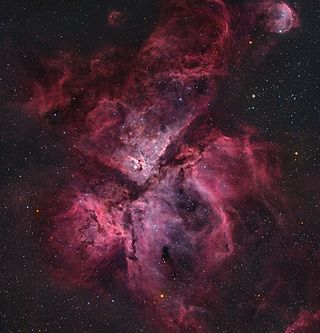
The Carina Nebula or Eta Carinae Nebula is a large, complex area of bright and dark nebulosity in the constellation Carina, located in the Carina–Sagittarius Arm of the Milky Way galaxy. The nebula is approximately 8,500 light-years (2,600 pc) from Earth.
HD 76728 is a suspected astrometric binary star system in the constellation Carina. It has the Bayer designation c Carinae; HD 76728 is the identifier from the Henry Draper catalogue. The visible component has a blue-white hue and is visible to the naked eye with an apparent visual magnitude of +3.84. The system is located at a distance of approximately 320 light years from the Sun based on parallax, and it is drifting further away with a radial velocity of around +25 km/s. It is a candidate member of the Volans-Carina Association of co-moving stars.

V533 Carinae is a white A-type supergiant variable star with a mean apparent magnitude of +4.59 in the constellation Carina. It is over 10,000 light years from Earth.

Rho Centauri, Latinized from ρ Centauri, is a binary star system in the southern constellation of Centaurus. It is visible to the naked eye as a blue-white hued point of light with a combined apparent visual magnitude of +3.97. The system is located approximately 276 light years from the Sun based on parallax, and is drifting further away with a radial velocity of around +15 km/s. It is a proper motion member of the Lower Centaurus–Crux sub-group in the Scorpius–Centaurus OB association, the nearest such association of co-moving massive stars to the Sun.
HD 113703, also known by the Bayer designation f Centauri, is a multiple star system in the southern constellation of Centaurus. The combined apparent visual magnitude of this system is +4.71, which is sufficient to make it faintly visible to the naked eye. The distance to this system is approximately 400 light years based on parallax measurements. It is a member of the Lower Centaurus Crux subgroup of the Scorpius–Centaurus association.
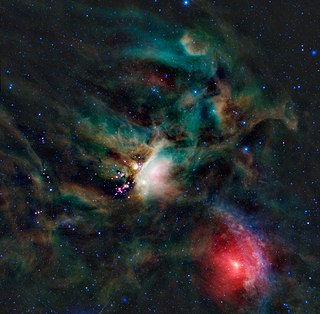
The Gould Belt is a local ring of stars in the Milky Way, tilted away from the galactic plane by about 16–20 degrees, first reported by John Herschel and Benjamin Gould in the 19th century. It contains many O- and B-type stars, and many of the nearest star-forming regions of the local Orion Arm, to which the Sun belongs. The relative proximity of these star-forming regions spurred the Gould Belt Survey project to determine what caused them.
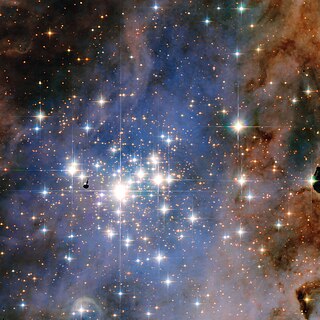
HD 93129 is a triple star system in the Carina Nebula, with all three components being hot O class stars amongst the most luminous stars in the Milky Way. It is the dominant member of the Trumpler 14 star cluster, a young star cluster within the Carina OB1 stellar association that harbors other super-luminous stars, like Eta Carinae and WR 25.

The Scorpius–Centaurus association is the nearest OB association to the Sun. This stellar association is composed of three subgroups and its distance is about 130 parsecs or 420 light-years. Using improved Hipparcos data, Rizzuto and colleagues analysed nearby stars more closely, bringing the number of known members to 436. They doubt the need to add a subclassification because they found a more continuous spread of stars.

λ Crucis, Latinized as Lambda Crucis, is a single, variable star in the southern constellation Crux, near the constellation border with Centaurus. It is visible to the naked eye as a faint, blue-white hued point of light with an apparent visual magnitude that fluctuates around 4.62. The star is located approximately 384 light-years distant from the Sun based on parallax, and is drifting further away with a radial velocity of +12 km/s. It is a proper motion member of the Lower Centaurus–Crux sub-group in the Scorpius–Centaurus OB association, the nearest such association of co-moving massive stars to the Sun.

HR Carinae is a luminous blue variable star located in the constellation Carina. It is surrounded by a vast nebula of ejected nuclear-processed material because this star has a multiple shell expanding atmosphere. This star is among the most luminous stars in the Milky Way. It has very broad emission wings on the Balmer lines, reminiscent from the broad lines observed in the spectra of O and Wolf–Rayet stars. A distance of 5 kpc and a bolometric magnitude of -9.4 put HR Car among the most luminous stars of the galaxy.

Cygnus OB2 is an OB association that is home to some of the most massive and most luminous stars known, including suspected Luminous blue variable Cyg OB2 #12. It also includes one of the largest known stars, NML Cygni. The region is embedded within a wider one of star formation known as Cygnus X, which is one of the most luminous objects in the sky at radio wavelengths. The region is approximately 1,570 parsecs from Earth in the constellation of Cygnus.

NGC 6604 is a young open cluster of stars in the equatorial constellation of Serpens, positioned about 1.5° north of the Eagle Nebula. The cluster was discovered by William Herschel on July 15, 1784. It is located at a distance of 4,580 light years from the Sun, about 210 ly (65 pc) above the galactic plane. NGC 6604 forms the densest part of the Ser OB2 association of co-moving stars.
BD+43 3654 is a massive luminous blue supergiant runaway star in the constellation Cygnus.
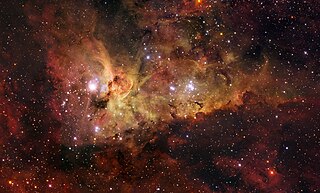
Trumpler 16 is a massive open cluster that is home to some of the most luminous stars in the Milky Way galaxy. It is situated within the Carina Nebula complex in the Carina–Sagittarius Arm, located approximately 9,270 ly (2,842 pc) from Earth. The cluster has one star visible to the naked eye from the tropics southward, Eta Carinae.

Trumpler 14 is an open cluster with a diameter of six light-years (1.8 pc), located within the inner regions of the Carina Nebula, approximately 8,980 light-years (2,753 pc) from Earth. Together with the nearby Trumpler 16, they are the main clusters of the Carina OB1 stellar association, which is the largest association in the Carina Nebula, although Trumpler 14 is not as massive or as large as Trumpler 16.

Carina OB1 is a giant OB association in the Carina Nebula, which is home to some of the most massive and luminous stars in the Milky Way Galaxy. It includes the young star clusters Collinder 228, NGC 3293, NGC 3324, IC 2581, Trumpler 14, Trumpler 15 and Trumpler 16, the last being the home of Eta Carinae. It also includes another massive and luminous star, HD 93129A. It is approximately 2,680 parsecs (8,700 ly) from Earth.

CK Carinae is a variable star in the constellation Carina, the keel of Argo Navis. It is a member of the star association Carina OB1-D, at a distance of around 2,300 parsecs or 7,500 light years.

V528 Carinae is a variable star in the constellation Carina.

IX Carinae is a red supergiant and pulsating variable star of spectral type M2Iab in the constellation Carina. It is a member of the Carina OB1 association along the Carina Nebula.
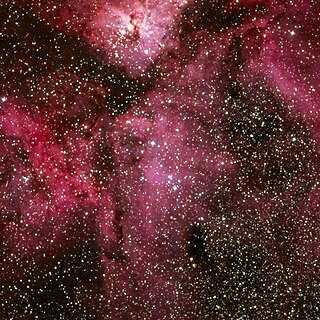
Collinder 228 is an open cluster within the southern part of the Carina Nebula NGC 3372, about 25' south of η Carinae. It is probably composed of stars which recently formed from the material in the nebula. QZ Carinae is the brightest member of Collinder 228 with an apparent magnitude between 6.16 and 6.49.
References
- ↑ Garcia, Beatriz (1994). "A study of Carina OB2 association. 2: Analysis and discussion of the data". Astrophysical Journal, Part 1. 436 (2): 705–19. Bibcode:1994ApJ...436..705G. doi:10.1086/174944.